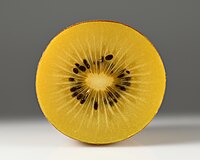
Photo from wikipedia
Kiwifruit (Actinidia chinensis var. deliciosa (A Chev) Liang et Ferguson) is a sub-tropical vine species from the Actinidiaceae family native to China. This species has an allohexaploid genome (from diploid… Click to show full abstract
Kiwifruit (Actinidia chinensis var. deliciosa (A Chev) Liang et Ferguson) is a sub-tropical vine species from the Actinidiaceae family native to China. This species has an allohexaploid genome (from diploid and autotetraploid parents), contained in 174 chromosomes producing a climacteric and fleshy fruit called kiwifruit. Currently, only a small body of transcriptomic and proteomic data are available for A. chinensis var. deliciosa. In this low molecular knowledge context, the main goal of this study is to construct a tissue-specific de novo transcriptome assembly, generating differential expression analysis among these specific tissues, to obtain new useful transcriptomic information for a better knowledge of vegetative, floral and fruit growth in this species. In this study, we have analyzed different whole transcriptomes from shoot, leaf, flower bud, flower and fruit at four development stages (7, 50, 120 and 160 days after flowering; DAF) in kiwifruit obtained through RNA-seq sequencing. The first version of the developed A. chinensis var. deliciosa de novo transcriptome contained 142,025 contigs (x¯ = 1044 bp, N50 = 1133 bp). Annotation was performed with BLASTX against the TAIR10 protein database, and we found an annotation proportion of 35.6% (50,508), leaving 64.4% (91,517) of the contigs without annotation. These results represent a reference transcriptome for allohexaploid kiwifruit generating a database of A. chinensis var. deliciosa genes related to leaf, flower and fruit development. These results provided highly valuable information identifying over 20,000 exclusive genes including all tissue comparisons, which were associated with the proteins involved in different biological processes and molecular functions.
Journal Title: Agronomy
Year Published: 2021
Link to full text (if available)
Share on Social Media: Sign Up to like & get
recommendations!